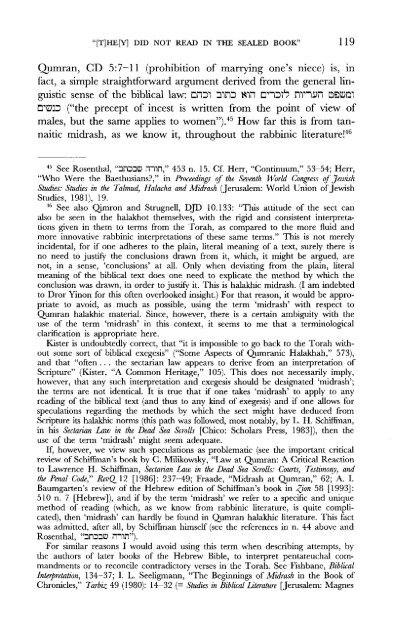historical perspectives: from the hasmoneans to bar kokhba in light ...
historical perspectives: from the hasmoneans to bar kokhba in light ...
historical perspectives: from the hasmoneans to bar kokhba in light ...
Create successful ePaper yourself
Turn your PDF publications into a flip-book with our unique Google optimized e-Paper software.
"[T]HE[Y] DID NOT READ IN THE SEALED BOOK" 119<br />
Qumran, CD 5:7-11 (prohibition of marry<strong>in</strong>g one's niece) is, <strong>in</strong><br />
fact, a simple straightforward argument derived <strong>from</strong> <strong>the</strong> general l<strong>in</strong>guistic<br />
sense of <strong>the</strong> biblical law:<br />
("<strong>the</strong> precept of <strong>in</strong>cest is written <strong>from</strong> <strong>the</strong> po<strong>in</strong>t of view of<br />
males, but <strong>the</strong> same applies <strong>to</strong> women"). 45 How far this is <strong>from</strong> tannaitic<br />
midrash, as we know it, throughout <strong>the</strong> rabb<strong>in</strong>ic literature! 46<br />
45 See Rosenthal, 453 n. 15. Cf. Herr, "Cont<strong>in</strong>uum," 53-54; Herr,<br />
"Who Were <strong>the</strong> Baethusians?," <strong>in</strong> Proceed<strong>in</strong>gs of <strong>the</strong> Seventh World Congress of Jewish<br />
Studies: Studies <strong>in</strong> <strong>the</strong> Talmud, Halacha and Midrash (Jerusalem: World Union of Jewish<br />
Studies, 1981), 19.<br />
46 See also Qimron and Strugnell, DJD 10.133: "This attitude of <strong>the</strong> sect can<br />
also be seen <strong>in</strong> <strong>the</strong> halakhot <strong>the</strong>mselves, with <strong>the</strong> rigid and consistent <strong>in</strong>terpretations<br />
given <strong>in</strong> <strong>the</strong>m <strong>to</strong> terms <strong>from</strong> <strong>the</strong> Torah, as compared <strong>to</strong> <strong>the</strong> more fluid and<br />
more <strong>in</strong>novative rabb<strong>in</strong>ic <strong>in</strong>terpretations of <strong>the</strong>se same terms." This is not merely<br />
<strong>in</strong>cidental, for if one adheres <strong>to</strong> <strong>the</strong> pla<strong>in</strong>, literal mean<strong>in</strong>g of a text, surely <strong>the</strong>re is<br />
no need <strong>to</strong> justify <strong>the</strong> conclusions drawn <strong>from</strong> it, which, it might be argued, are<br />
not, <strong>in</strong> a sense, 'conclusions' at all. Only when deviat<strong>in</strong>g <strong>from</strong> <strong>the</strong> pla<strong>in</strong>, literal<br />
mean<strong>in</strong>g of <strong>the</strong> biblical text does one need <strong>to</strong> explicate <strong>the</strong> method by which <strong>the</strong><br />
conclusion was drawn, <strong>in</strong> order <strong>to</strong> justify it. This is halakhic midrash. (I am <strong>in</strong>debted<br />
<strong>to</strong> Dror Y<strong>in</strong>on for this often overlooked <strong>in</strong>sight.) For that reason, it would be appropriate<br />
<strong>to</strong> avoid, as much as possible, us<strong>in</strong>g <strong>the</strong> term 'midrash' with respect <strong>to</strong><br />
Qumran halakhic material. S<strong>in</strong>ce, however, <strong>the</strong>re is a certa<strong>in</strong> ambiguity with <strong>the</strong><br />
use of <strong>the</strong> term 'midrash' <strong>in</strong> this context, it seems <strong>to</strong> me that a term<strong>in</strong>ological<br />
clarification is appropriate here.<br />
Kister is undoubtedly correct, that "it is impossible <strong>to</strong> go back <strong>to</strong> <strong>the</strong> Torah without<br />
some sort of biblical exegesis" ("Some Aspects of Qumranic Halakhah," 573),<br />
and that "often . . . <strong>the</strong> sectarian law appears <strong>to</strong> derive <strong>from</strong> an <strong>in</strong>terpretation of<br />
Scripture" (Kister, "A Common Heritage," 105). This does not necessarily imply,<br />
however, that any such <strong>in</strong>terpretation and exegesis should be designated 'midrash';<br />
<strong>the</strong> terms are not identical. It is true that if one takes 'midrash' <strong>to</strong> apply <strong>to</strong> any<br />
read<strong>in</strong>g of <strong>the</strong> biblical text (and thus <strong>to</strong> any k<strong>in</strong>d of exegesis) and if one allows for<br />
speculations regard<strong>in</strong>g <strong>the</strong> methods by which <strong>the</strong> sect might have deduced <strong>from</strong><br />
Scripture its halakhic norms (this path was followed, most notably, by L. H. Schiff<strong>in</strong>an,<br />
<strong>in</strong> his Sectarian Law <strong>in</strong> <strong>the</strong> Dead Sea Scrolls [Chico: Scholars Press, 1983]), <strong>the</strong>n <strong>the</strong><br />
use of <strong>the</strong> term 'midrash' might seem adequate.<br />
If, however, we view such speculations as problematic (see <strong>the</strong> important critical<br />
review of Schiffman's book by C. Milikowsky, "Law at Qumran: A Critical Reaction<br />
<strong>to</strong> Lawrence H. Schiff<strong>in</strong>an, Sectarian Law <strong>in</strong> <strong>the</strong> Dead Sea Scrolls: Courts, Testimony, and<br />
<strong>the</strong> Penal Code" RevQ 12 [1986]: 237-49; Fraade, "Midrash at Qumran," 62; A. I.<br />
Baumgarten's review of <strong>the</strong> Hebrew edition of Schiffman's book <strong>in</strong> Zion 58 [1993]:<br />
510 n. 7 [Hebrew]), and if by <strong>the</strong> term 'midrash' we refer <strong>to</strong> a specific and unique<br />
method of read<strong>in</strong>g (which, as we know <strong>from</strong> rabb<strong>in</strong>ic literature, is quite complicated),<br />
<strong>the</strong>n 'midrash' can hardly be found <strong>in</strong> Qumran halakhic literature. This fact<br />
was admitted, after all, by Schiff<strong>in</strong>an himself (see <strong>the</strong> references <strong>in</strong> n. 44 above and<br />
Rosenthal, ).<br />
For similar reasons I would avoid us<strong>in</strong>g this term when describ<strong>in</strong>g attempts, by<br />
<strong>the</strong> authors of later books of <strong>the</strong> Hebrew Bible, <strong>to</strong> <strong>in</strong>terpret pentateuchal commandments<br />
or <strong>to</strong> reconcile contradic<strong>to</strong>ry verses <strong>in</strong> <strong>the</strong> Torah. See Fishbane, Biblical<br />
Interpretation, 134-37; I. L. Seeligmann, "The Beg<strong>in</strong>n<strong>in</strong>gs of Midrash <strong>in</strong> <strong>the</strong> Book of<br />
Chronicles," Tarbiz 49 (1980): 14-32 (= Studies <strong>in</strong> Biblical Literature [Jerusalem: Magnes

















